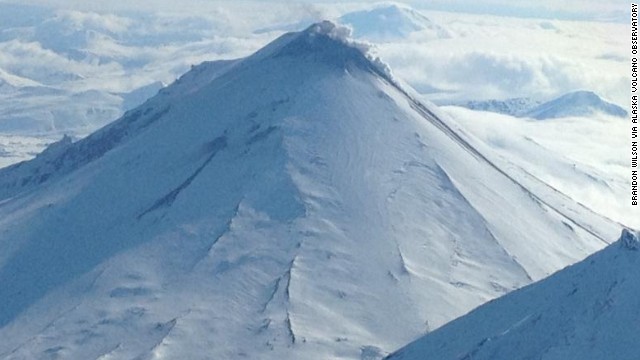Updated 7:49 AM EDT, Wed May 15, 2013

Fresh lava flows off Pavlof volcano on May 13, 2013. The photo was taken from a plane at about 10,500 feet.
Lava flowed Tuesday from two Alaskan volcanoes, with authorities placing both on the second-highest alert levels because "sudden explosions ... are possible with little or no warning."
The volcanoes are Pavlof and Cleveland, both in the Aleutian Island range southwest of mainland Alaska. The
Alaska Volcano Observatory has issued a watch due to heightened activity, plus an orange code regarding how they might affect planes in the area.
At Pavlof, the higher of the two summits at 8,261 feet, the observatory reported "eruptive activity" that followed "an increase in seismic activity." Lava has been spotted about 0.3 of a mile (half a kilometer) down the volcano's north flank.
Unlike Cleveland, Pavlof is not on an island but rather is connected to the Alaskan mainland.
The 5,676-foot high Cleveland is about 350 miles to the southwest. It has 100-meter wide swath of lavaextending about 1 mile down its southeastern flank, according to the Alaska Volcano Observatory.
That organization noted Cleveland could produce ash clouds rising more than 20,000 feet above sea level. Beyond any impact on fish, wildlife and humans, large ash clouds could negatively impact air travel.
"They are very similar, and both have the ability to erupt," John Power, a scientist from the U.S. Geological Survey, told CNN.
After "eruptive activity" last year at the Cleveland volcano, University of Alaska Fairbanks scientist Steve McNutt noted that 90% of air freight from Asia to Europe and North America flies over Alaska airspace, and hundreds of flights fly through Anchorage's air space daily.
Why some travelers seek out world's most dangerous locales
"We think of the Aleutian Islands as being remote and desolate" Power explained, "but when you come up to 30,000 feet we are talking about 20 to 30,000 people there every single day."
Power described Pavlof as "one of the most historically active volcanoes in the Northern Hemisphere. Cleveland is also "very active," having last had a large eruption in 2001.
A complicating and potentially troubling factor for Cleveland is it's not monitored with ground instruments, like Pavlof. Years of declining budgets have made adding such technology, to such a remote locale, increasingly challenging..
And all of it means it takes longer for anyone to realize Cleveland erupts, which could prove hazardous for any planes flying through.
"For instance, ... on May 4, we had a sizable eruption, and we weren't even aware for about 40 minutes," Power said.